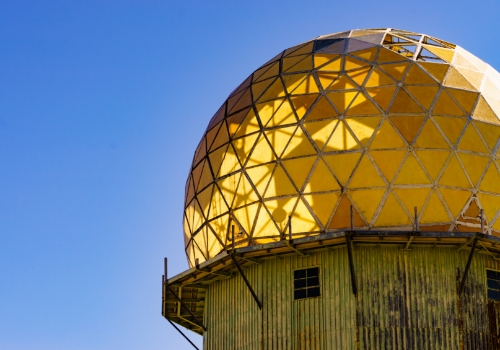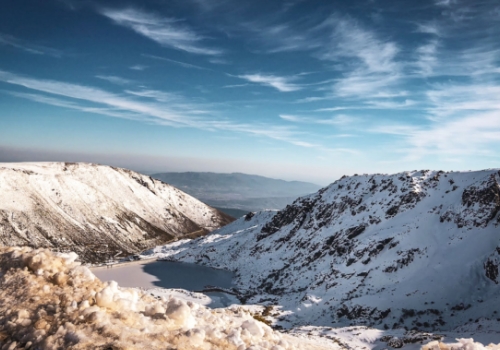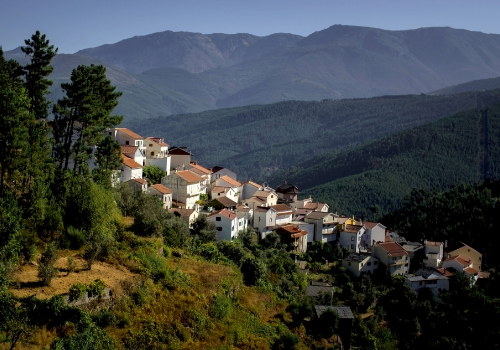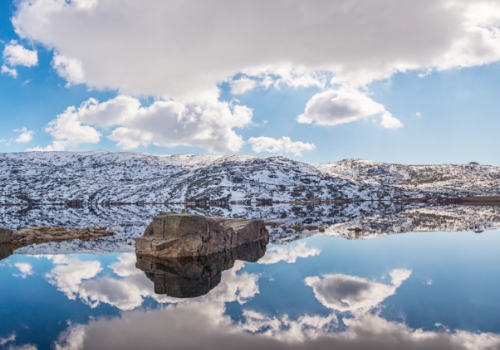Guerin® Blog
Explore the best destinations: Guerin
Discover Portugal: 14 Natural Parks to explore
Share
Although our country is known for its countless beaches from north to south, spread along a continental coastline more than 940 km long, the country's tourism also includes the mountain landscapes and the various natural parks that Portugal has.
With destinations that continue to preserve all their natural beauty and demonstrate a great variety of fauna and flora species, one of the ways of protecting them is to classify them as Natural Parks and Reserves. Enter on this journey with Guerin and find out all there is to explore in 14 nature parks in mainland Portugal.
Nature Parks in Portugal from north to south
For all the adventurers and those who love renting a car to travel without a certain destination, embarking on a trip towards a natural park will always be seen as a good option for a holiday or a weekend getaway, as tranquillity and nature coexist in harmony. So, prepare a backpack, choose comfortable footwear, because we promise that there is much to know in our list of natural parks in Portugal.

The North includes the country's only national park, in a region demarcated by a landscape full of contrasts and which includes some of Portugal's most recognisable scenery. Take note of everything you have to know in this part of the country.
1) Peneda-Gêres National Park
With an extension of about 70 thousand hectares, it is the only national park in the country since 1971 and is considered by UNESCO as a World Biosphere Reserve. It stretches from the plateaus of Mourela to Castro Laboreiro and includes well-known destinations such as Soajo, Gêres, Peneda or Amarela, divided between the regions of Minho and Barroso (Trás-os-Montes).
This is one of Portugal's most highly regarded natural parks, as it is still home to dozens of granite villages, which preserve the style of the oldest villages. In fact, in the most isolated parts of the park, wildlife lives in its splendour: we can find various wild animals, such as wolves, wild boar, deer and horses, but also various domesticated species, which in the quiet of Gerês graze for months.
2) Alvão Natural Park
Another of Portugal's natural parks located in the north of the country is the Natural Park of Alvão, with an extension of about 7 thousand hectares, in an area where granite rules. In Vila Pouca de Aguiar, one of the most expected traditions of the year is the "arrastão da pedra" (stone dragging), an event that brings together about 700 people, from the 14 parishes of the municipality, to drag a giant granite block with about 12 tons.
The Olo river flows through here, where we find one of the most famous waterfalls in Portugal: Fisgas do Ermelo. It is also an incredible area for those who enjoy a good walk, with several trails waiting to be explored, where along the way you will find some rare plant species, such as the orvalhinha or the rorela (a carnivorous plant).
If you pass through this park, don't be surprised if you see several bridges with wolves drawn on them: these are specially created walkways so that Iberian wolves can cross the motorway without major constraints.
3) Montesinho Natural Park
Located in the northern part of the counties of Bragança and Vinhais, the so-called Terra Fria Transmontana, the Natural Park of Montesinho includes Serra da Coroa and Serra de Montesinho, in an extension of about 74 thousand hectares.
Being one of the largest natural parks in Portugal, here the fauna and flora proliferate in more than 150 species of birds and Iberian wolf, but also heaths and cistus. As the municipality of Bragança is the largest producer of chestnuts in Portugal, chestnut trees are also a species that predominate in the landscape. All, without forgetting the schist rocks.

4) International Douro Natural Park
Located in one of the regions that most fans conquer all over the world, this is one of the natural parks in Portugal where a stop is mandatory! This park covers the entire area of the Douro River, being the natural border between Spain and Portugal. It includes the municipalities of Miranda do Douro, Freixo de Espada à Cinta, Mogadouro and Castelo Rodrigo.
It has an extension of 86,000 hectares, marked by holm oak and juniper forests, but also where rupicolours birds, such as the Egyptian vulture, nest, this being the group with the greatest representativeness in the area.
5) North Coast Natural Park
This natural park is in the coastal area and therefore includes an extension of over 7000 hectares of marine and/or estuarine area alone, with a total of 16 km of coastline. From Apúlia (Esposende) to the Neiva River estuary, this park is made up of the largest stretch of Atlantic dunes in northern Portugal.
There are more than 200 species of plants that can be found in this park, as well as more than 140 species of birds in the terrestrial area alone.
Nature Parks of the Centre
Since 1999, we celebrate May 24th as the "European Day of Nature Parks", and Portugal mainland has a total of 13 parks to venture into, 14 if you count the Peneda-Gerês National Park. Discover now the natural parks in the centre of the country.
6) Arrábida Natural Park
There are more than 5 thousand hectares of marine area in the Arrábida Natural Park, plus the incredible 12 thousand hectares on land. Nobody can remain indifferent to one of the most beautiful natural parks in Portugal, with the mountains enchanting the landscape, ending in the paradisiacal waters of the Atlantic, which here appear of a limpid blue.
Here you will find countless trails that cut through the mountains and introduce you to vegetation where the scent of plants such as rosemary, lavender, rosemary, and lavender prevail. The Arrábida Natural Park also includes the Professor Luiz Saldanha Marine Park, a marine area of great biodiversity, with about 1350 species of marine fauna and flora.
7) Serra da Estrela Natural Park
Within the national parks of Portugal, we find the Serra da Estrela Natural Park, which is located in the central mountainous massif, being the largest Portuguese protected area. It was elevated to world Geopark in 2020 by UNESCO.
Situated on the highest point of mainland Portugal, where rain and even snow falls frequently, the fauna of this park includes many mammals and birds, but also small reptiles and amphibians.
With a glacial origin, this mountain range is made up of the Zêzere and Unhais valleys, the covões and around 25 natural lagoons.

8) Serra de São Mamede Natural Park
The Parque Natural da Serra de São Mamede is in the border region of the Nordeste Alentejano, where the green landscape contrasts with the warm tones that the Alentejo has already accustomed us to. The summit of the mountain is the highest point south of the Tagus, in a landscape of predominantly oak and chestnut trees.
There are at least five hiking trails that mark this park, where you can find and observe some rare species of birds of prey such as the griffon vulture or the harpy eagle.
Here you can visit medieval villages such as Castelo de Vide, Marvão and Alegrete. There are several flavours that stand out in this region, allowing you to add to your adventure an authentic gastronomic itinerary.
9) Aire and Candeeiros Mountains Natural Park
One of the best-known natural parks in Portugal is the Serras de Aire and Candeeiro Natural Park, situated only 100 km from Lisbon. It is 39 thousand hectares protected since 1979, covering counties such as Alcobaça or Santarém.
It is an area where we find a lot of limestone and, therefore, the greatest wealth of the Serras de Aire and Candeeiros Natural Park is hidden inside: the landscape is marked by countless caves and other formations.
Here you will also find about 600 species of flora, from wild orchids to species endemic to the country. As in other natural parks in Portugal, there are several species of birds that choose these mountains to nest. To get to know this protected area, you can choose from the 16 pedestrian routes proposed by the park team.

10) Sintra-Cascais Natural Park
Very close to Lisbon, we come to the Sintra-Cascais Natural Park, which stretches from the mouth of the Falcão River (Sintra) to the Guia area, in Cascais. Sintra's natural beauty has been captivating everyone who passes through it for decades, with the old town embedded in a dense forest of various species, where gardens were also one of the passions of the Portuguese kings.
Cabo da Roca is one of the most spectacular sites in the Sintra-Cascais Natural Park, or the fossil dunes consolidated at Magoito and Oitavos, and the 16th century Capuchos Convent.
From the various types of oak trees to the palaces hidden among the trees, to the enviable fauna with various specimens of birds of prey and sea birds, rent a car at our stations in the region and save at least two days to discover the main secrets of Sintra, which is on the UNESCO World Heritage List as a "cultural landscape".
11) International Tagus Natural Park
The Tagus has an undeniable beauty, and its extension often reminds us of the sea. Therefore, it is not surprising that one of the natural parks of Portugal is located here: we are talking about the Natural Park of International Tagus, with more than 26 thousand hectares.
It covers the valley of the border stretch of the river Tagus, neighbouring valleys, and adjacent flattened areas. It extends over territory belonging to the municipalities of Castelo Branco, Idanha-a-Nova, and Vila Velha de Ródão.
It is still a conservation area for several species of nesting birds, such as the imperial eagle or the black stork. The waters hide some threatened fish species endemic to the Iberian Peninsula.
12) Guadiana Valley Natural Park
The Guadiana Valley Natural Park covers an area of 69 thousand hectares. In this area of Alentejo we find steep valleys, with crags and Mediterranean juniper or holm oak woods. But already at the river line, the landscape changes to receive willows or oleanders.
Most of the natural parks in Portugal are in river areas or near the sea, and this park is no different: the hydrographic basin of the Guadiana is the most important in Portugal for the conservation of inland water fish, where out of 10 Iberian species, 4 exist only in this basin. Within the amphibians, of the 17 species that can be seen in our country, at least 13 can be observed in this park.
This is an important area for rupicolours birds, especially the imperial eagle, or for steppe birds such as the great bustard. In the northern area you will find one of the main points that attracts the most people: the Pulo do Lobo, a unique waterfall.
Southern Nature Park
Nature tourism attracts more and more fans, and the south has long since got us used to the idea that this part of the country is not only about beaches. Discover, therefore, the two natural parks of Portugal that are here waiting for you.
13) Southwest Alentejo and Vicentine Coast Natural Park
After reading our itinerary for the Vicentine Coast, get to know even more about one of Portugal's most recognized natural parks inside and outside the country: the Parque Natural do Sudoeste Alentejano and Costa Vicentina.
Stretching over more than 100 kms of coastline from Porto Covo in the Alentejo to Burgau in the Algarve, this park includes several unique species of fauna and flora and is therefore visited by many zoologists and botanists from all over the world.
Various species of birds choose this place to rest and nest, such as the rare fishing eagles or the white storks, the latter being the only place in the world where they nest on the sea cliffs.
When we talk about the flora of the Costa Vicentina, we are talking about a park that has the largest number of priority species in the country and some only exist here: the Biscutella vicentina or the Plantago Almogravensis.
14) Ria Formosa Natural Park
The Ria Formosa Natural Park is one of the most amazing places in the Algarve: making the transition between sea and land, the Ria Formosa is a large-scale lagoon system, stretching over 60 km of the Algarve's leeward coast and occupying around 18,000 hectares, between the Ancão peninsula, Loulé, and Manta Rota, Vila Real de Santo António.
It is the most important wetland in the south of Portugal and includes a wide variety of habitats: barrier islands, salt marshes, sand banks, dunes, salt pans, freshwater and brackish water lagoons, water courses, woods, agricultural areas, which also provide a huge diversity of fauna and flora.
The avifauna is powerful here, being the place chosen by many birds from northern and central Europe to spend their winter, sheltering rare species such as the sultana hen. It is also a famous nursery for marine species and to produce bivalve molluscs.
Follow the pedestrian trails that cross this park and take the opportunity to get to know it through boat trips. Don't be alarmed if you suddenly come across an important inhabitant of this park: the chameleon!
Travel through Portugal's natural parks with Guerin
To make this tour of Portugal's nature parks a reality, trust Guerin to rent a car.
Select the Guerin car rental stations nearest you, choose the car from our fleet which is most appropriate for your trip, from passenger cars to luxury sports cars or 7 or 9-seat vans, and make the most of this unique trip.

Share
